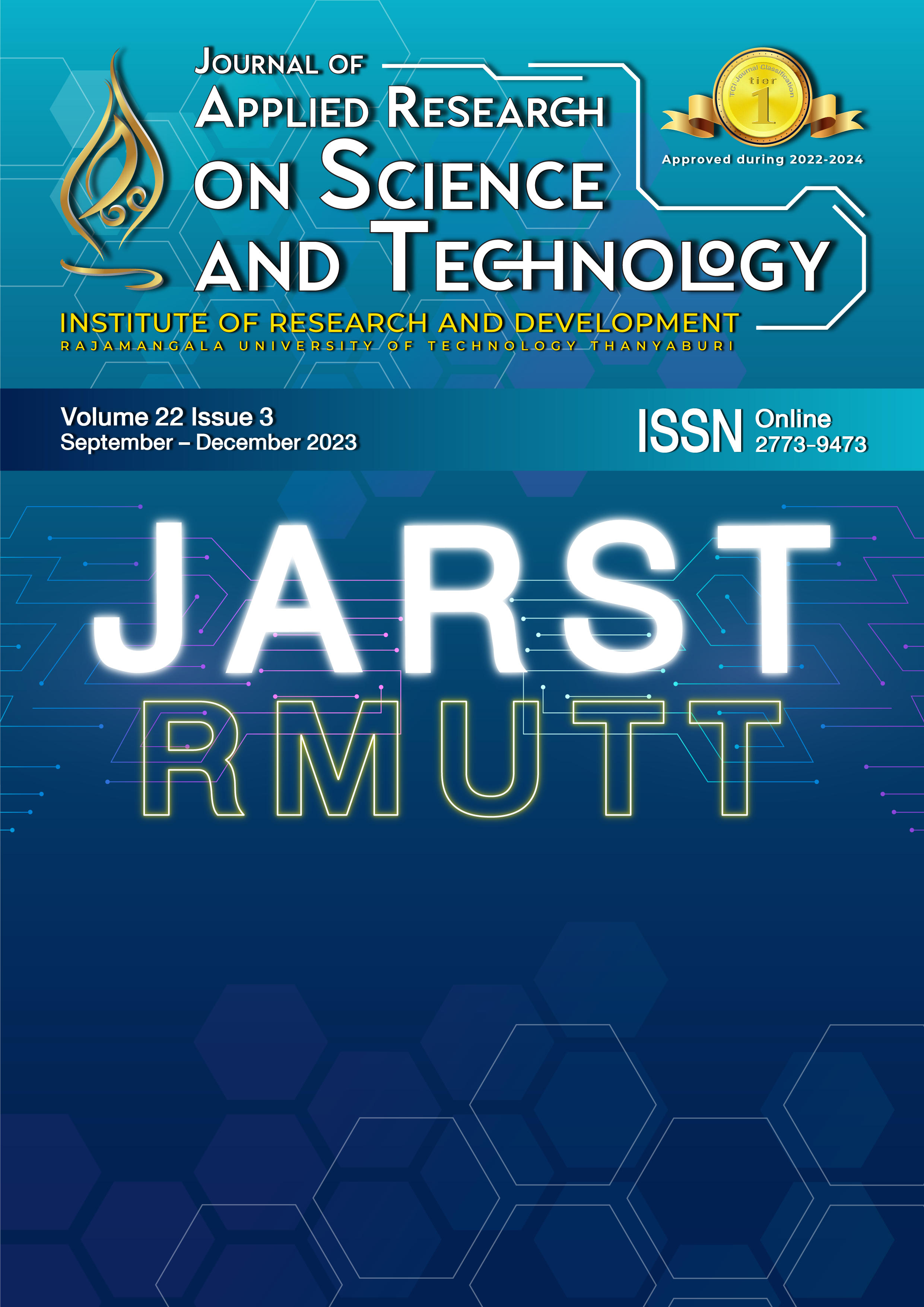Microencapsulation of moringa oil in bio-polymer by simple solvent evaporation technique
Main Article Content
Abstract
Moringa oil (MO) contains various bioactive components and pharmacology. It is attractive to use as a raw ingredient in various products. However, there are limitations on its direct utilization, especially MO's instability and hastening the active ingredient's degradation from external environmental factors, including temperature, humidity, oxidation, light, and heat. To solve these problems, in this work, microencapsulation of MO using different biopolymers as cellulose acetate butyrate (CAB), ethyl cellulose (EC), and poly(L-lactic acid) (PLLA) were carried out by a simple solvent evaporation technique. The prepared polymer microcapsule suspensions were highly colloidal stable for all types of biopolymers and ratios. The spherical biopolymer capsules were formed to a micrometer size after solvent evaporation under all conditions. However, when the microcapsules were dried, aggregation was found with the polymer microcapsules at a ratio of PLLA to MO of 50:50 for all three types of polymers, possibly due to the low amount of polymer to completely encapsulate all of MO. When polymer contents increased to 70%, the dried spherical polymer microcapsules were smoothly produced. Using 70% polymers, the PLLA microcapsule surface was smoother than the polymer microcapsules prepared by CAB and EC which exhibited the dent or hole on the outer surface. Micrometer size, spherical polymer capsules with a core-shell morphology were fabricated. Due to the higher hydrophilicity of the polymer than the MO, the polymer moves outward, forming a strong shell around the MO. Then, all three biopolymers can be used for the microencapsulation of MO at a suitable polymer to MO ratio. However, using PLLA at a ratio of PLLA to MO of 70:30 presented the highest encapsulation efficiency (74.08%), which may be due to its high molecular weight. Because of the non-toxicity and biodegradability of biopolymers, the fabricated microcapsules would be well applied in cosmetic products.
Article Details

This work is licensed under a Creative Commons Attribution-NonCommercial-NoDerivatives 4.0 International License.
References
Ozioko FUOFU. Synthesis and study of properties of biolubricant based on Moringa oleifera oil for industrial application. AU Journal of Technology. 2014;17(3):137-42.
Cáceres A, Saravia A, Rizzo S, Zabala L, De Leon E, Nave F. Pharmacologie properties of Moringa oleifera. 2: Screening for antispasmodic, antiinflammatory and diuretic activity. J Ethnopharmacol. 1992;36(3):233-7.
Mahmood KT, Mugal T, Haq IU. Moringa oleifera: a natural gift-A review. Journal of Pharmaceutical Sciences and Research. 2010;2(11):775.
Ferreira RS, Napoleão TH, Santos AFS, Sá RA, Carneiro‐da‐Cunha MG, Morais MMC, et al. Coagulant and antibacterial activities of the water‐soluble seed lectin from Moringa oleifera. Lett Appl Microbiol. 2011;53(2):186-92.
Burt S. Essential oils: their antibacterial properties and potential applications in foods—a review. Int J Food Microbiol. 2004;94(3):223-53.
Paulo F, Santos L. Design of experiments for microencapsulation applications: A review. Materials Science and Engineering: C. 2017;77:1327-40.
Teeka P, Chaiyasat A, Chaiyasat P. Preparation of poly (methyl methacrylate) microcapsule with encapsulated jasmine oil. Enrgy Proced. 2014;56:181-6.
Chaiyasat P, Pholsrimuang P, Boontung W, Chaiyasat A. Influence of poly(l-lactic acid) molecular weight on the encapsulation efficiency of urea in microcapsule using a simple solvent evaporation technique. Polym-Plast Technol. 2016;55(11):1131-6.
Chaiyasat P, Chaiyasat A, Teeka P, Noppalit S, Srinorachun U. Preparation of poly(l-lactic acid) microencapsulated Vitamin E. Enrgy Proced. 2013;34:656-63.
Chaiyasat P, Kamlangmak N, Hangmi K, Rattanawongwiboon T, Chaiyasat A. Fabrication of cellulose-based particles/capsules using gamma radiation-initiated radical precipitation polymerization. Int J Polym Mater Po. 2022;1-11.
Pang L, Gao Z, Feng H, Wang S, Wang Q. Cellulose based materials for controlled release formulations of agrochemicals: A review of modifications and applications. Journal of Controlled Release. 2019;316:105-15.
Wang X, Yin H, Chen Z, Xia L. Epoxy resin/ethyl cellulose microcapsules prepared by solvent evaporation for repairing microcracks: Particle properties and slow-release performance. Materials Today Communications. 2020;22:100854.
Moreno JS, Dima P, Chronakis IS, Mendes AC. Electrosprayed ethyl cellulose core-shell microcapsules for the encapsulation of probiotics. Pharmaceutics. 2022;14(1):7.
Ponce Cevallos PA, Buera MP, Elizalde BE. Encapsulation of cinnamon and thyme essential oils components (cinnamaldehyde and thymol) in β-cyclodextrin: Effect of interactions with water on complex stability. J Food Eng. 2010;99(1):70-5.
Amit Kumar P, Shinichi S. Recent Developments in the Crystallization of PLLA-Based Blends, Block Copolymers, and Nanocomposites. In: Youssef Ben S, Riadh M, editors. Crystallization and Applications. Rijeka: IntechOpen; 2021. p. Ch. 5.
Jelvehgari M, Montazam SH. Comparison of microencapsulation by emulsion-solvent extraction/evaporation technique using derivatives cellulose and acrylate-methacrylate copolymer as carriers. Jundishapur J Nat Pharm Prod. 2012;7(4):144-52.
Prakash K, Raju P, Shanta K, Lakshmi M. Preparation and characterization of lamivudine microcapsules using various cellulose polymers. Trop J Pharm Res. 2007;6(4):841-7.
Junyaprasert VB, Manwiwattanakul G. Release profile comparison and stability of diltiazem–resin microcapsules in sustained release suspensions. International Journal of Pharmaceutics. 2008;352(1):81-91.
Beşen BS. Tea tree oil/ethyl cellulose microcapsule loaded antimicrobial textiles. AATCC Journal of Research. 2020;7(2):1-6.
Khotchana C, Phapugrangkul P, Opaprakasit P, Kaewpa D, Chaiyasat P, Chaiyasat A. Synthesis of uniform submicron poly(lactic acid)-based particles/capsules by radical precipitation polymerization. Colloids and Surfaces B: Biointerfaces. 2021;208:112122.
Sangjun P, Chaiyasat A. Poly(l-lactic acid)-based microcapsule containing phase-change material: Influence of polymer shell on particle morphology. Fiber Polym. 2020;21(5):935-43.
Kesente M, Kavetsou E, Roussaki M, Blidi S, Loupassaki S, Chanioti S, et al. Encapsulation of olive leaves extracts in biodegradable PLA nanoparticles for use in cosmetic formulation. Bioengineering. 2017;4(3):75-89.
Brlek I, Ludaš A, Sutlović A. Synthesis and Spectrophotometric analysis of microcapsules containing immortelle essential oil. Molecules. 2021;26(8):2390-9.
Amim J, Kosaka PM, Petri DFS. Characteristics of thin cellulose ester films spin-coated from acetone and ethyl acetate solutions. Cellulose. 2008;15(4):527-35.
Liu L, Yang JP, Ju XJ, Xie R, Yang L, Liang B, et al. Microfluidic preparation of monodisperse ethyl cellulose hollow microcapsules with non-toxic solvent. Journal of Colloid and Interface Science. 2009;336(1):100-6.
Chung TW, Huang YY, Liu YZ. Effects of the rate of solvent evaporation on the characteristics of drug loaded PLLA and PDLLA microspheres. International Journal of Pharmaceutics. 2001;212(2):161-9.
Liu R, Ma G, Meng FT, Su ZG. Preparation of uniform-sized PLA microcapsules by combining Shirasu porous glass membrane emulsification technique and multiple emulsion-solvent evaporation method. J Control Release. 2005;103(1):31-43.


